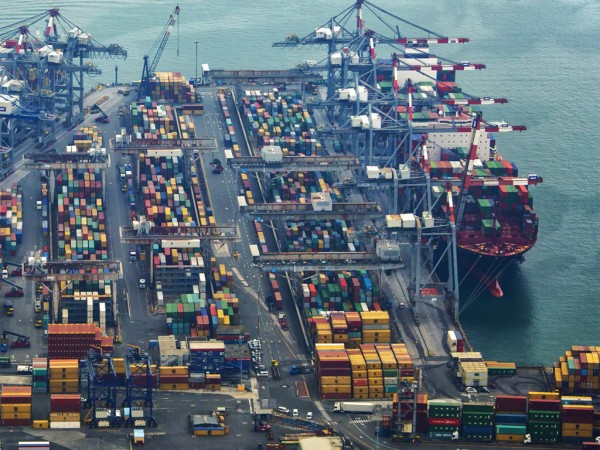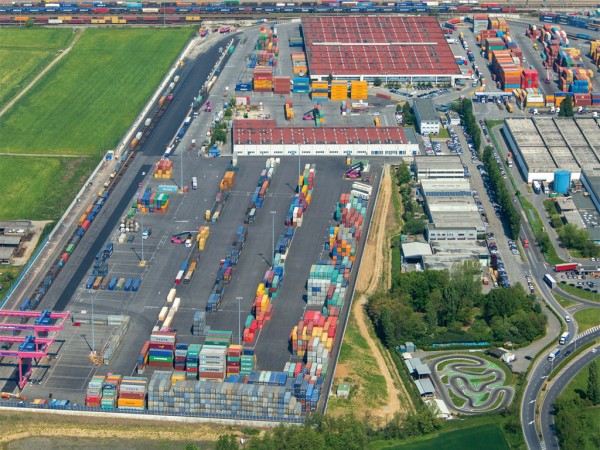Port and Contship promote southern trade gateway
The shape of the Italian peninsula is most often thought of as a boot, but it can also be seen as a huge pier stretching into the Mediterranean Sea. That’s how the folks at the Port of La Spezia and the logistics company Contship would like you to view their country. Representatives of Contship and the La Spezia Port Authority were in New York on September 12 to promote the virtues of trading with Europe through their respective organizations.

La Spezia also has ambitions to capture trade from elsewhere in Europe. A recent deal with the Swiss supermarket operator Migros, has seen a growing level of imports being handled through the Port of La Spezia, with the level of trade from Switzerland growing ten-fold in the last four years. The eventual extension of the Gotthard tunnel from Switzerland to Italy will enhance the ability of Italian ports to handle Swiss trade, enabling longer and heavier trains to transit between the two countries—and rail connections are one of La Spezia’s hallmarks.
These facts suggest what the Italians hope is the beginning of a shift in orientation in European trade. Whereas currently, as much as 70% of trade transits northern European ports, developments in Italy and elsewhere could flip that figure on its head in the coming years.
“Italy is at the center of the Mediterranean,” noted Francesco Genuardi, Italy’s consul general in New York, who hosted the September 12 event. “Italy connects Europe to Africa and the Middle East.”
The Port of La Spezia had its start as the first military and strategic port of the Italian kingdom, dating back to 1869. It is currently the second largest port in Italy for container final destination services, handling around 1.4 million TEUs and 60 million tons of cargo last year.
“From La Spezia, you can reach the most important markets in Europe,” said Francesco di Sarcina, secretary general of the La Spezia Port Authority.
La Spezia’s catchment area reaches 47% of Italy’s GDP. “It is a gateway to many provinces in north and central Italy,” said di Sarcina. “Shippers are also able to reach central and southern Europe through La Spezia. We are investing in logistics infrastructure to improve the speed of our cargo handling.”
Crucially, around 35% of container traffic handled at La Spezia is transported by rail—as compared to the average of nine to 10% among Italian ports—with over 200 trains per week serving the port. The giant intermodal transshipment center at Melzo, east of Milan, with the capacity to handle 7,000 trains per year, is a crucial piece of La Spezia’s cargo-handling operation.
“The proximity to Melzo provides logistics advantages to La Spezia more so than the size of the port itself,” said Daniele Testi, director of Contship Italy.
The port’s master plan calls for increasing operational areas of the commercial ports by 25% through public-private partnerships, including arrangements with Contship. The plan calls for new roads to be built, new ground spaces to be dedicated, with investments in the hundreds of millions of dollars.
“This expansion will increase the port’s capacity to two-million TEUs per year,” said di Sarcina. “We have the goal also to handle 50% of containers by rail.” The expanded port will also include three areas for berthing large container ships of up to 16,000 TEU and nine rail lines serving the port area. La Spezia was the first Italian port to handle the new generation of larger container ships and is now served by four carrier strings that cover all of North America: to Montreal, the east coast, gulf coast, and west coast.
Contship and La Spezia Expansion
Contship started out in the container shipping business but has since sold its vessels to concentrate on providing integrated door-to-door logistics services through its maritime terminal and rail assets. The company’s hubs are located in Tangiers, Morocco and in La Spezia, Ravenna, and Salerno, Italy.
“We handle one in four containers handled through the Port of La Spezia,” noted Testi, “and also have a 25% intermodal market share there.”

Contship and La Spezia are jointly promoting the port as a southern gateway to European trade. “Switzerland has historically been served from Germany,” noted Testi. “We want to push an alternative.”
Contship currently provides daily rail service from La Spezia to Basel, Zurich, and Munich, and other services are on the drawing boards, according to Testi. Contship plans to add to its Swiss customer roster by “getting the attention of beneficial cargo owners,” said Testi.
The Swiss retailer Migros was attracted to La Spezia from a risk management standpoint. “They decided they’d better not stick with just one trade corridor,” said Testi. Migros performed a month-long trial run, importing tuna into Switzerland via La Spezia, and the relationship grew from there.
The value proposition of the southern gateway is that it saves shippers money, to the tune of $70 per $100,000-shipment per day. Testi claims it “is not a big deal” to save three days of transit time going through La Spezia, which would save shippers over $200 per shipment. Terminal charges in La Spezia are also cheaper, 22 percent less than ports in northern Europe.
The ultimate goal is to turn the trade map of Europe upside down. “The current north-south ratio is around 70-to-30,” said Testi. “In the future it could be 65 to 70 percent in favor of the south.”




